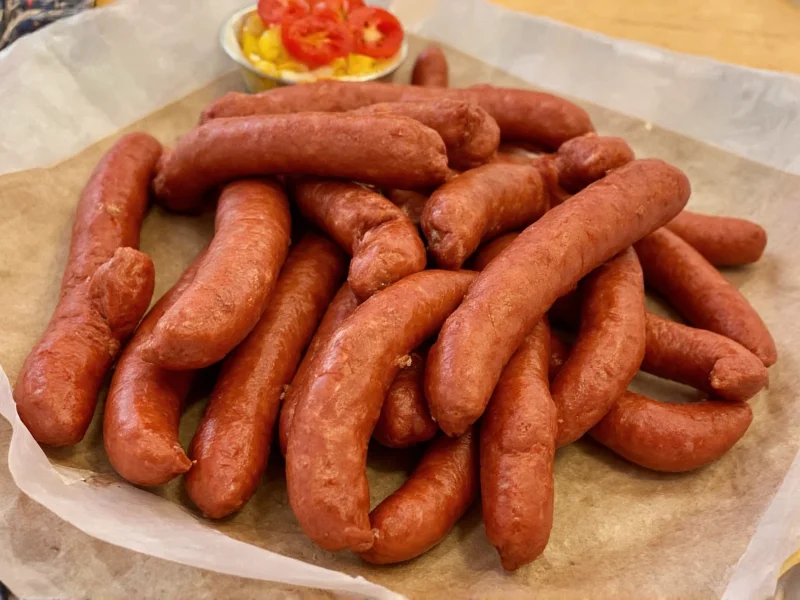When exploring evergood sausage varieties, consumers discover a product line that emphasizes traditional sausage-making techniques combined with modern quality control standards. The brand has established itself in regional markets through consistent product quality and attention to authentic flavor profiles that appeal to discerning palates.
History and Craftsmanship Behind Evergood Sausage
Evergood sausage traces its origins to family-owned meat processing traditions that date back several decades. Unlike mass-produced alternatives, Evergood maintains smaller batch production methods that allow for greater quality control throughout the manufacturing process. The company's commitment to traditional sausage preparation has earned it a loyal following among consumers who prioritize authentic meat products.
What distinguishes evergood sausage ingredients is their focus on high-quality meat selection, typically using 70-80% premium cuts with minimal fillers. Their seasoning blends incorporate natural spices without artificial preservatives, appealing to health-conscious consumers seeking cleaner ingredient lists. This approach positions Evergood as a mid-tier specialty sausage option that balances quality with accessibility.
Popular Evergood Sausage Varieties
Evergood offers several distinctive sausage varieties that cater to different culinary applications and regional preferences. Understanding these options helps consumers select the right product for their specific cooking needs.
| Variety | Key Characteristics | Best Cooking Methods |
|---|---|---|
| Classic Bratwurst | Pork-based, mild seasoning, natural casing | Grilling, pan-frying, beer-boiling |
| Italian Sweet | Pork and beef blend, fennel-forward seasoning | Pasta dishes, sandwiches, grilling |
| Breakfast Links | Pork-based, maple and sage seasoning | Pan-frying, oven-baking |
| Smoked Kielbasa | Beef and pork blend, garlic and pepper seasoning | Stews, soups, direct grilling |
Where to Find Evergood Sausage Products
Locating where to buy evergood sausage requires understanding its regional distribution pattern. Unlike national brands with widespread supermarket presence, Evergood maintains a more focused distribution strategy:
- Regional grocery chains - Primarily available in Midwest and Northeastern United States
- Specialty butcher shops - Often carried by independent butchers who prioritize quality meat products
- Farmer's markets - Available at select markets during peak seasons
- Online ordering - Limited availability through regional meat delivery services
Consumers searching for evergood sausage near me should check local butcher directories or contact regional grocery chains directly, as availability varies significantly by location. The brand's website typically features a store locator function for the most current purchasing options.
Culinary Applications and Preparation Tips
Professional chefs and home cooks appreciate evergood sausage cooking recommendations for maximizing flavor and texture. Proper preparation techniques significantly impact the final dish quality:
- Thawing properly - When using frozen products, allow 24 hours in the refrigerator for even thawing
- Temperature control - Cook to an internal temperature of 160°F (71°C) for safety without drying out
- Gradual heating - Start with lower heat to render fat before increasing temperature for browning
- Resting period - Allow cooked sausages to rest 3-5 minutes before serving for optimal juiciness
For those exploring best evergood sausage recipes, consider these versatile applications:
- Breakfast links work exceptionally well in stratas and quiches
- Italian varieties enhance pasta sauces and pizza toppings
- Bratwurst shines when paired with sauerkraut and traditional German sides
- Kielbasa adds depth to bean soups and stews
Quality Considerations When Purchasing Evergood Sausage
When evaluating is evergood sausage good quality, consider these objective factors that distinguish premium sausage products:
- Meat-to-fat ratio - Quality sausages maintain a balanced ratio (typically 70-80% lean meat)
- Casing type - Natural casings provide better texture and "snap" than synthetic alternatives
- Ingredient transparency - Clear labeling of meat sources and minimal additives
- Consistent diameter - Indicates proper filling techniques and quality control
- Freshness indicators - Bright meat color and absence of excessive liquid in packaging
Compared to mass-market alternatives, Evergood generally demonstrates stronger performance in these quality metrics, making it a reliable choice for consumers seeking better-than-average sausage products without gourmet pricing.
Frequently Asked Questions
Where can I purchase Evergood sausage products?
Evergood sausage is primarily available through regional grocery chains in the Midwest and Northeastern United States, specialty butcher shops, and select farmer's markets. Some regions offer online ordering through local meat delivery services. The brand's official website typically features a store locator for the most current purchasing options in your area.
What makes Evergood sausage different from other brands?
Evergood sausage distinguishes itself through smaller batch production methods, higher quality meat selection (typically 70-80% premium cuts), natural casings, and seasoning blends without artificial preservatives. Unlike mass-produced alternatives, Evergood maintains traditional sausage-making techniques with modern quality control standards, resulting in consistent flavor and texture across their product line.
How should I properly cook Evergood sausage for best results?
For optimal results when cooking Evergood sausage, thaw frozen products gradually in the refrigerator for 24 hours. Cook to an internal temperature of 160°F (71°C), starting with lower heat to render fat before increasing temperature for browning. Allow cooked sausages to rest 3-5 minutes before serving. Different varieties work best with specific methods: bratwurst benefits from beer-boiling before grilling, while Italian varieties excel in pasta dishes and on sandwiches.
Does Evergood sausage contain artificial preservatives or fillers?
Evergood sausage typically uses natural preservatives and minimal fillers compared to mass-market alternatives. Their products generally feature clean ingredient lists with recognizable spices and seasonings. Most varieties contain 70-80% premium meat cuts with the remainder consisting of natural seasonings and small amounts of necessary binders. Always check the specific product label for complete ingredient information as formulations may vary by sausage type.
What are the most popular Evergood sausage varieties?
Evergood's most popular sausage varieties include Classic Bratwurst (pork-based with mild seasoning), Italian Sweet (pork and beef blend with fennel-forward seasoning), Breakfast Links (pork with maple and sage), and Smoked Kielbasa (beef and pork blend with garlic and pepper). Each variety serves different culinary applications, from traditional German pairings for bratwurst to pasta dishes for Italian varieties and breakfast applications for their maple-sage links.











 浙公网安备
33010002000092号
浙公网安备
33010002000092号 浙B2-20120091-4
浙B2-20120091-4